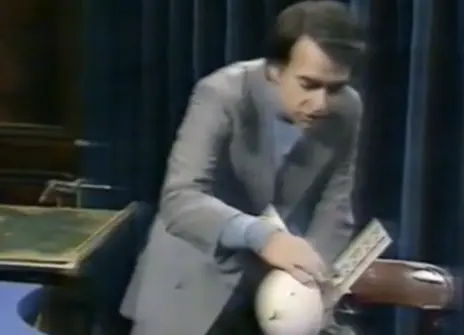Lecture 2 - The outer solar system and life
From ancient organisms to the plants and animals we see today, our planet showcases a spectacular array of life. But beneath such diversity lies an underlying unity. All life on Earth is based on two molecules (the proteins and the nucleic acids) and the origin of these molecules in the early stages of our planet’s development is inextricably linked to the origin of life.
In his second CHRISTMAS LECTURES, Carl Sagan travels beyond Earth to explore the possibility of life in outer space.
To find the answer, he looks back to the early stages of the development of our atmosphere. The hydrogen from this atmosphere has since escaped to space from Earth, but not from bigger planets like Jupiter. When the hydrogen-rich gases of the early Earth are mixed together and supplied with energy, the essential molecular building blocks of the proteins and nucleic acids are formed.
As Carl suggests, although this process no longer occurs on Earth, such organic chemistry should be occurring in the outer solar system on Jupiter, and Titan, Saturn’s largest moon. The NASA twin spacecraft Voyager 1 and 2, launched a few months prior to these Lectures in 1977, were sent to space to explore this hypothesis.
About the 1977 CHRISTMAS LECTURES
What exists beyond Earth? Over six Lectures presented in 1977, American astronomer and cosmologist Carl Sagan explores the vast expanse of space that surrounds the third planet from the Sun.
Life on Earth
Where at first we could only discern the size of our planet and some knowledge of its atmosphere and configuration, the evolution of planetary exploration has revealed not only intricate details of Earth’s climate and geology, but a multitude of stars and planets besides our own.
Beginning with a closer look at the world we inhabit, Carl explores of the diversity of life on our own planet and the building blocks behind it, before questioning whether the same organic chemistry is occurring on planets in the outer solar system.
The Red Planet
In Lecture three onwards, Carl takes a closer look at our neighbouring planet, Mars. From early interpretations of terrestrial life on its surface to the surprising discoveries made by NASA’s Viking Program, the Red Planet has become the focus of efforts to discern whether intelligent life exists elsewhere in the universe.
When Carl delivered his Lectures in the late 1970s, NASA had only just begun its Voyager program to the furthest planets in our solar system and no extra-solar planets were known to exist. Now, over three decades later, astronomers are looking at planets that lie beyond our solar system to ask the very same question we pondered over Mars: is there life out there?





